Project, Risk, and Quality Management: Modern Developments and Future
VerifiedAdded on 2020/04/07
|9
|2581
|37
Report
AI Summary
This report delves into the multifaceted realm of project, risk, and quality management. It begins by tracing the evolution of project management perspectives, highlighting its strategic importance in contemporary business. The report emphasizes the significance of risk management, exploring various risk types and their impact on project outcomes, including scope creep and timely delivery. It then examines the interplay between risk and quality management, outlining essential strategies like planning and monitoring. The report further explores modern developments in project management, such as procedural documentation, continuous improvement, competency models, and capacity planning, and their implications for future projects. It concludes by suggesting proactive measures, including conflict management and risk mitigation, to ensure project viability and successful completion, offering valuable insights for project managers and stakeholders alike.
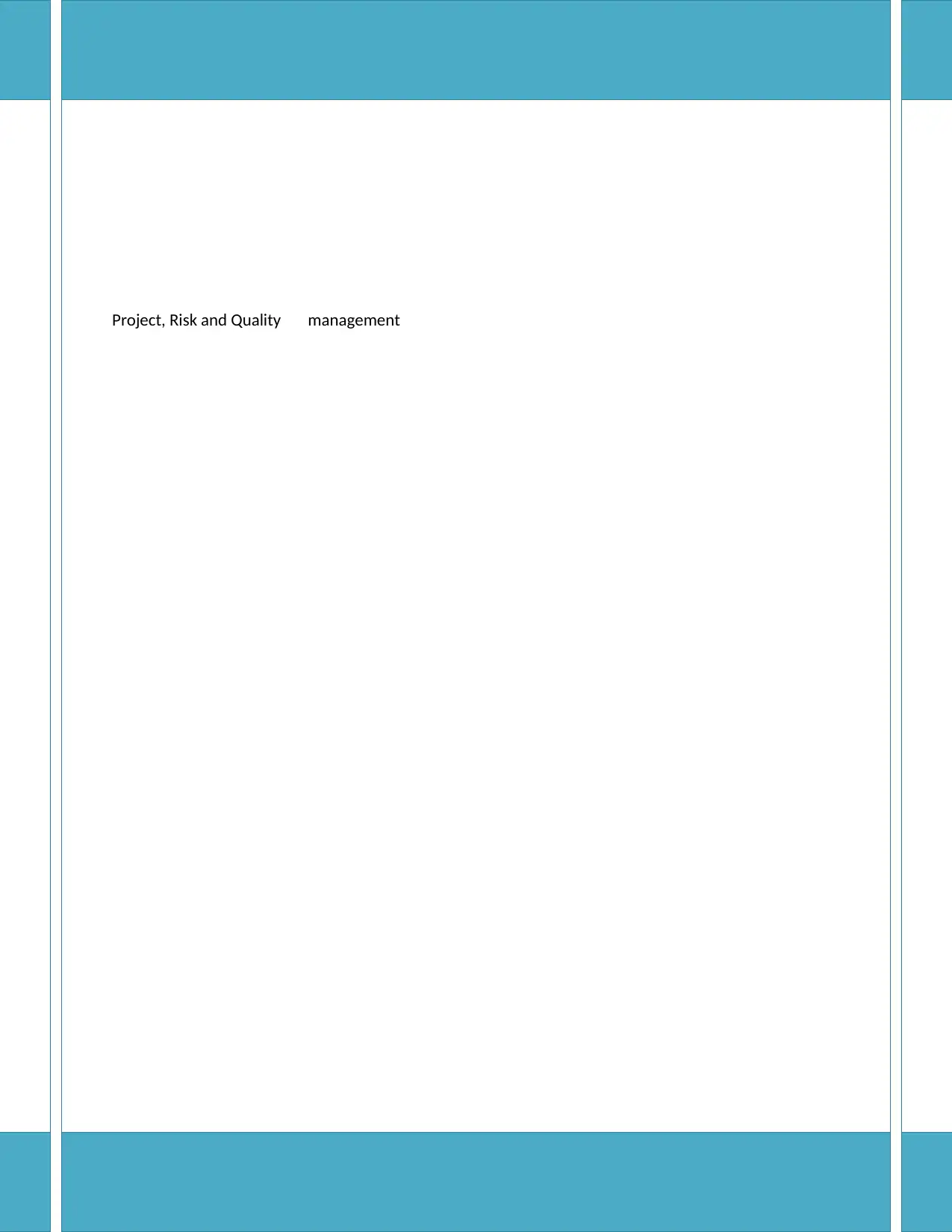
Project, Risk and Quality management
Paraphrase This Document
Need a fresh take? Get an instant paraphrase of this document with our AI Paraphraser
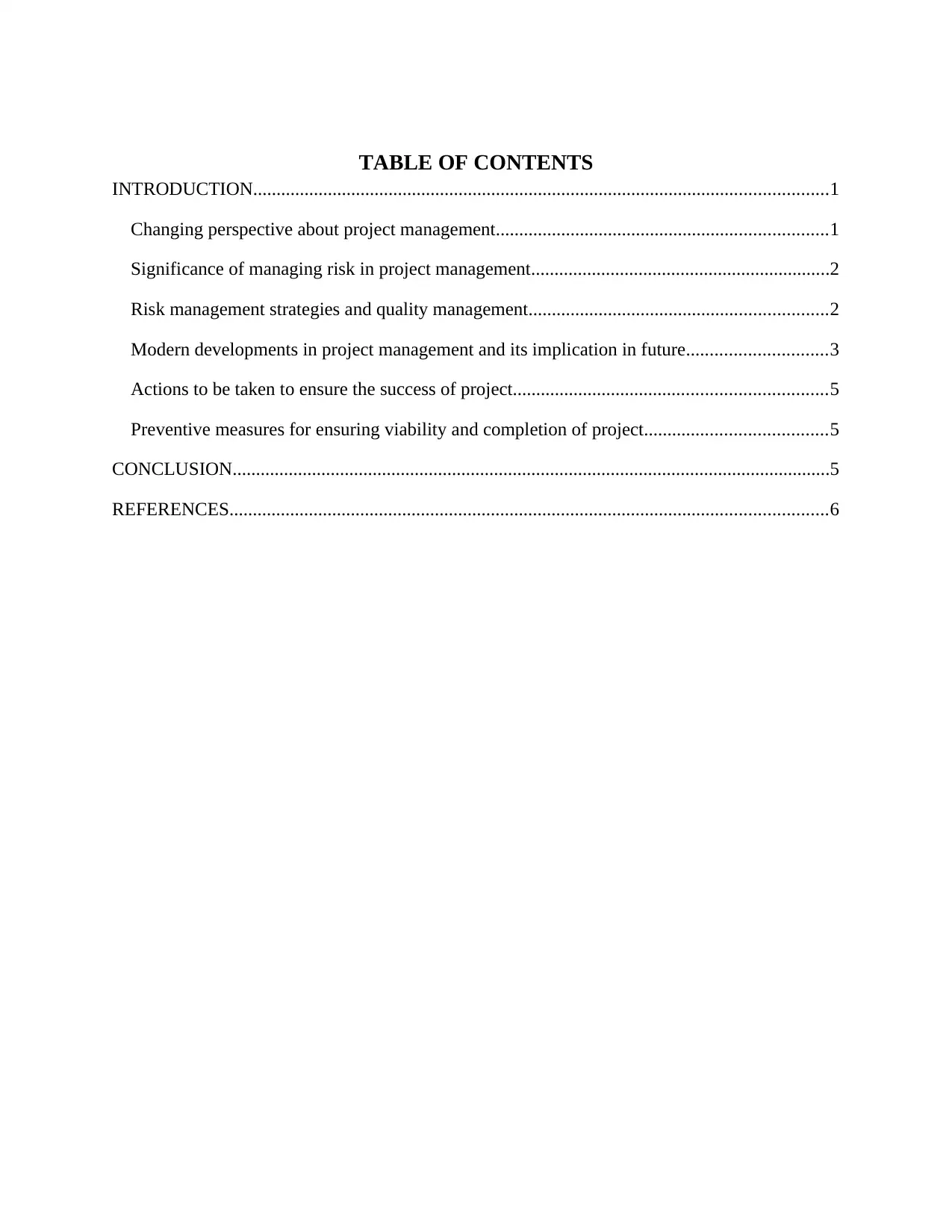
TABLE OF CONTENTS
INTRODUCTION...........................................................................................................................1
Changing perspective about project management.......................................................................1
Significance of managing risk in project management................................................................2
Risk management strategies and quality management................................................................2
Modern developments in project management and its implication in future..............................3
Actions to be taken to ensure the success of project...................................................................5
Preventive measures for ensuring viability and completion of project.......................................5
CONCLUSION................................................................................................................................5
REFERENCES................................................................................................................................6
INTRODUCTION...........................................................................................................................1
Changing perspective about project management.......................................................................1
Significance of managing risk in project management................................................................2
Risk management strategies and quality management................................................................2
Modern developments in project management and its implication in future..............................3
Actions to be taken to ensure the success of project...................................................................5
Preventive measures for ensuring viability and completion of project.......................................5
CONCLUSION................................................................................................................................5
REFERENCES................................................................................................................................6
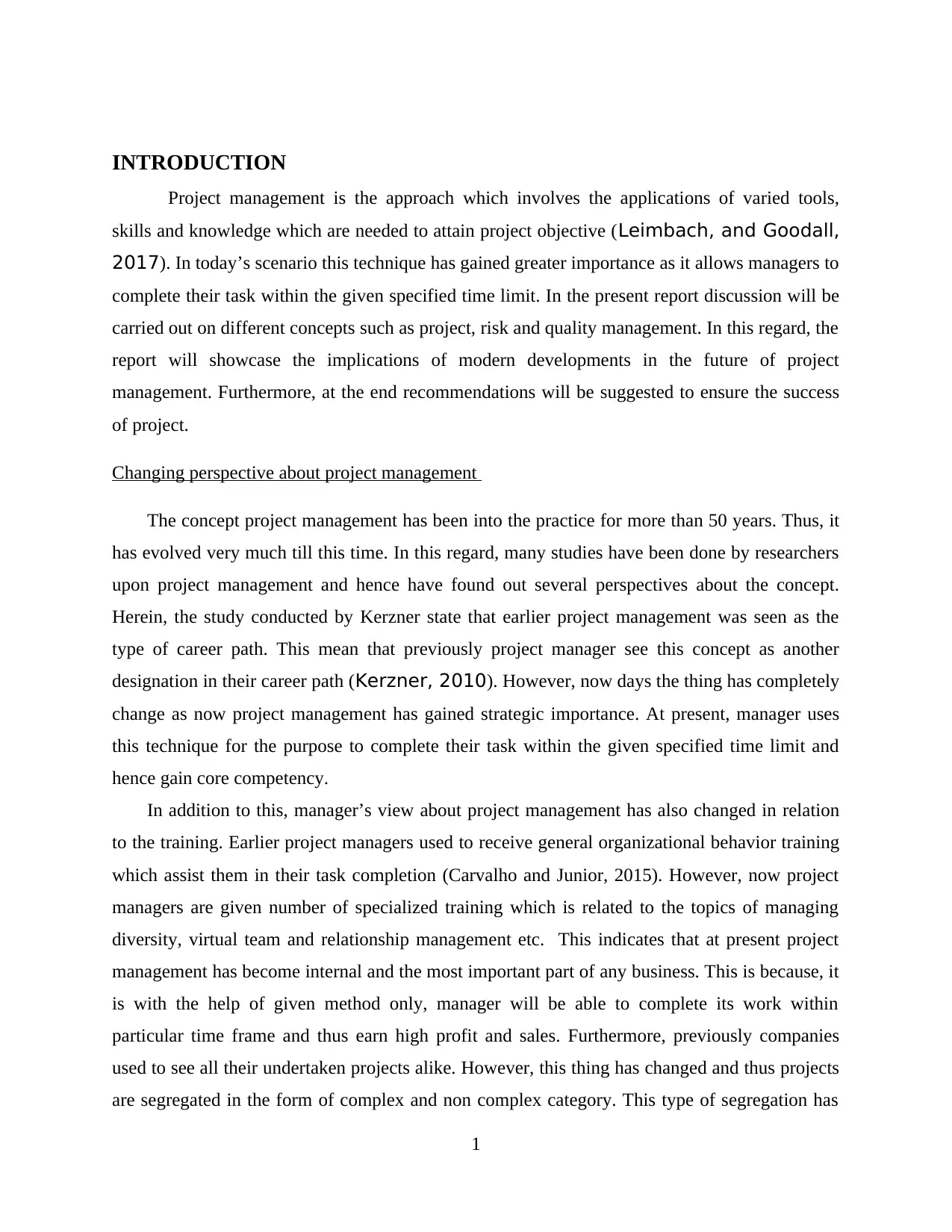
INTRODUCTION
Project management is the approach which involves the applications of varied tools,
skills and knowledge which are needed to attain project objective (Leimbach, and Goodall,
2017). In today’s scenario this technique has gained greater importance as it allows managers to
complete their task within the given specified time limit. In the present report discussion will be
carried out on different concepts such as project, risk and quality management. In this regard, the
report will showcase the implications of modern developments in the future of project
management. Furthermore, at the end recommendations will be suggested to ensure the success
of project.
Changing perspective about project management
The concept project management has been into the practice for more than 50 years. Thus, it
has evolved very much till this time. In this regard, many studies have been done by researchers
upon project management and hence have found out several perspectives about the concept.
Herein, the study conducted by Kerzner state that earlier project management was seen as the
type of career path. This mean that previously project manager see this concept as another
designation in their career path (Kerzner, 2010). However, now days the thing has completely
change as now project management has gained strategic importance. At present, manager uses
this technique for the purpose to complete their task within the given specified time limit and
hence gain core competency.
In addition to this, manager’s view about project management has also changed in relation
to the training. Earlier project managers used to receive general organizational behavior training
which assist them in their task completion (Carvalho and Junior, 2015). However, now project
managers are given number of specialized training which is related to the topics of managing
diversity, virtual team and relationship management etc. This indicates that at present project
management has become internal and the most important part of any business. This is because, it
is with the help of given method only, manager will be able to complete its work within
particular time frame and thus earn high profit and sales. Furthermore, previously companies
used to see all their undertaken projects alike. However, this thing has changed and thus projects
are segregated in the form of complex and non complex category. This type of segregation has
1
Project management is the approach which involves the applications of varied tools,
skills and knowledge which are needed to attain project objective (Leimbach, and Goodall,
2017). In today’s scenario this technique has gained greater importance as it allows managers to
complete their task within the given specified time limit. In the present report discussion will be
carried out on different concepts such as project, risk and quality management. In this regard, the
report will showcase the implications of modern developments in the future of project
management. Furthermore, at the end recommendations will be suggested to ensure the success
of project.
Changing perspective about project management
The concept project management has been into the practice for more than 50 years. Thus, it
has evolved very much till this time. In this regard, many studies have been done by researchers
upon project management and hence have found out several perspectives about the concept.
Herein, the study conducted by Kerzner state that earlier project management was seen as the
type of career path. This mean that previously project manager see this concept as another
designation in their career path (Kerzner, 2010). However, now days the thing has completely
change as now project management has gained strategic importance. At present, manager uses
this technique for the purpose to complete their task within the given specified time limit and
hence gain core competency.
In addition to this, manager’s view about project management has also changed in relation
to the training. Earlier project managers used to receive general organizational behavior training
which assist them in their task completion (Carvalho and Junior, 2015). However, now project
managers are given number of specialized training which is related to the topics of managing
diversity, virtual team and relationship management etc. This indicates that at present project
management has become internal and the most important part of any business. This is because, it
is with the help of given method only, manager will be able to complete its work within
particular time frame and thus earn high profit and sales. Furthermore, previously companies
used to see all their undertaken projects alike. However, this thing has changed and thus projects
are segregated in the form of complex and non complex category. This type of segregation has
1
⊘ This is a preview!⊘
Do you want full access?
Subscribe today to unlock all pages.

Trusted by 1+ million students worldwide
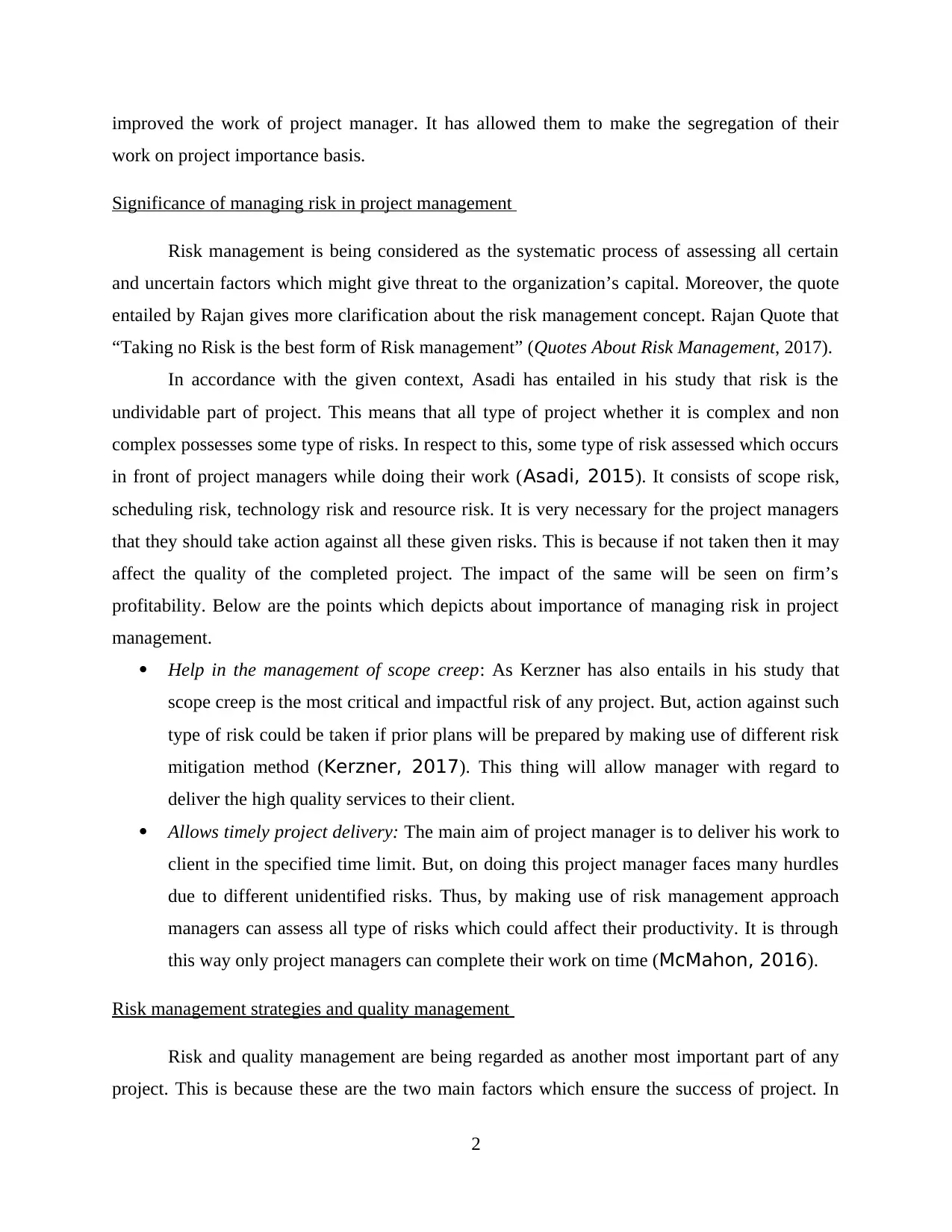
improved the work of project manager. It has allowed them to make the segregation of their
work on project importance basis.
Significance of managing risk in project management
Risk management is being considered as the systematic process of assessing all certain
and uncertain factors which might give threat to the organization’s capital. Moreover, the quote
entailed by Rajan gives more clarification about the risk management concept. Rajan Quote that
“Taking no Risk is the best form of Risk management” (Quotes About Risk Management, 2017).
In accordance with the given context, Asadi has entailed in his study that risk is the
undividable part of project. This means that all type of project whether it is complex and non
complex possesses some type of risks. In respect to this, some type of risk assessed which occurs
in front of project managers while doing their work (Asadi, 2015). It consists of scope risk,
scheduling risk, technology risk and resource risk. It is very necessary for the project managers
that they should take action against all these given risks. This is because if not taken then it may
affect the quality of the completed project. The impact of the same will be seen on firm’s
profitability. Below are the points which depicts about importance of managing risk in project
management.
Help in the management of scope creep: As Kerzner has also entails in his study that
scope creep is the most critical and impactful risk of any project. But, action against such
type of risk could be taken if prior plans will be prepared by making use of different risk
mitigation method (Kerzner, 2017). This thing will allow manager with regard to
deliver the high quality services to their client.
Allows timely project delivery: The main aim of project manager is to deliver his work to
client in the specified time limit. But, on doing this project manager faces many hurdles
due to different unidentified risks. Thus, by making use of risk management approach
managers can assess all type of risks which could affect their productivity. It is through
this way only project managers can complete their work on time (McMahon, 2016).
Risk management strategies and quality management
Risk and quality management are being regarded as another most important part of any
project. This is because these are the two main factors which ensure the success of project. In
2
work on project importance basis.
Significance of managing risk in project management
Risk management is being considered as the systematic process of assessing all certain
and uncertain factors which might give threat to the organization’s capital. Moreover, the quote
entailed by Rajan gives more clarification about the risk management concept. Rajan Quote that
“Taking no Risk is the best form of Risk management” (Quotes About Risk Management, 2017).
In accordance with the given context, Asadi has entailed in his study that risk is the
undividable part of project. This means that all type of project whether it is complex and non
complex possesses some type of risks. In respect to this, some type of risk assessed which occurs
in front of project managers while doing their work (Asadi, 2015). It consists of scope risk,
scheduling risk, technology risk and resource risk. It is very necessary for the project managers
that they should take action against all these given risks. This is because if not taken then it may
affect the quality of the completed project. The impact of the same will be seen on firm’s
profitability. Below are the points which depicts about importance of managing risk in project
management.
Help in the management of scope creep: As Kerzner has also entails in his study that
scope creep is the most critical and impactful risk of any project. But, action against such
type of risk could be taken if prior plans will be prepared by making use of different risk
mitigation method (Kerzner, 2017). This thing will allow manager with regard to
deliver the high quality services to their client.
Allows timely project delivery: The main aim of project manager is to deliver his work to
client in the specified time limit. But, on doing this project manager faces many hurdles
due to different unidentified risks. Thus, by making use of risk management approach
managers can assess all type of risks which could affect their productivity. It is through
this way only project managers can complete their work on time (McMahon, 2016).
Risk management strategies and quality management
Risk and quality management are being regarded as another most important part of any
project. This is because these are the two main factors which ensure the success of project. In
2
Paraphrase This Document
Need a fresh take? Get an instant paraphrase of this document with our AI Paraphraser
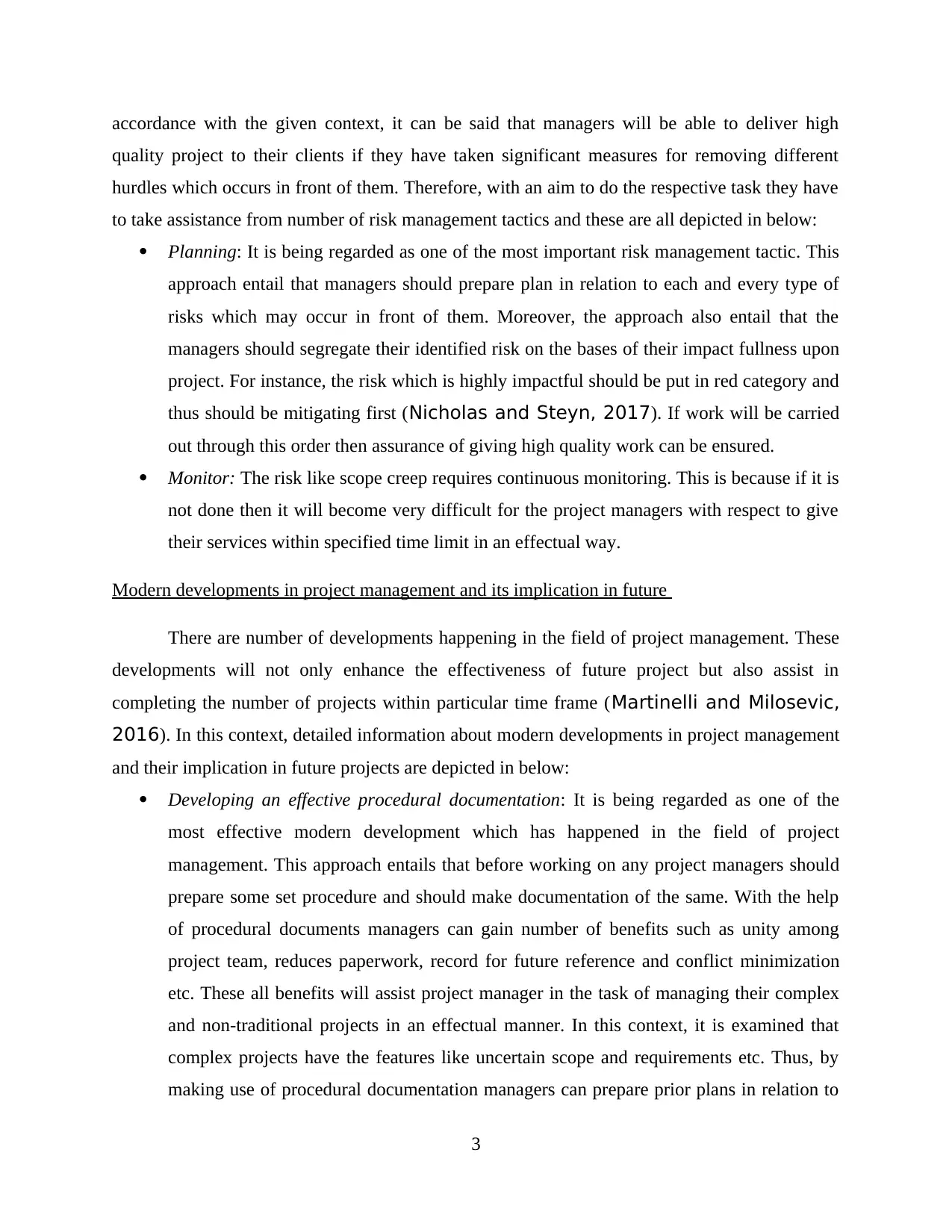
accordance with the given context, it can be said that managers will be able to deliver high
quality project to their clients if they have taken significant measures for removing different
hurdles which occurs in front of them. Therefore, with an aim to do the respective task they have
to take assistance from number of risk management tactics and these are all depicted in below:
Planning: It is being regarded as one of the most important risk management tactic. This
approach entail that managers should prepare plan in relation to each and every type of
risks which may occur in front of them. Moreover, the approach also entail that the
managers should segregate their identified risk on the bases of their impact fullness upon
project. For instance, the risk which is highly impactful should be put in red category and
thus should be mitigating first (Nicholas and Steyn, 2017). If work will be carried
out through this order then assurance of giving high quality work can be ensured.
Monitor: The risk like scope creep requires continuous monitoring. This is because if it is
not done then it will become very difficult for the project managers with respect to give
their services within specified time limit in an effectual way.
Modern developments in project management and its implication in future
There are number of developments happening in the field of project management. These
developments will not only enhance the effectiveness of future project but also assist in
completing the number of projects within particular time frame (Martinelli and Milosevic,
2016). In this context, detailed information about modern developments in project management
and their implication in future projects are depicted in below:
Developing an effective procedural documentation: It is being regarded as one of the
most effective modern development which has happened in the field of project
management. This approach entails that before working on any project managers should
prepare some set procedure and should make documentation of the same. With the help
of procedural documents managers can gain number of benefits such as unity among
project team, reduces paperwork, record for future reference and conflict minimization
etc. These all benefits will assist project manager in the task of managing their complex
and non-traditional projects in an effectual manner. In this context, it is examined that
complex projects have the features like uncertain scope and requirements etc. Thus, by
making use of procedural documentation managers can prepare prior plans in relation to
3
quality project to their clients if they have taken significant measures for removing different
hurdles which occurs in front of them. Therefore, with an aim to do the respective task they have
to take assistance from number of risk management tactics and these are all depicted in below:
Planning: It is being regarded as one of the most important risk management tactic. This
approach entail that managers should prepare plan in relation to each and every type of
risks which may occur in front of them. Moreover, the approach also entail that the
managers should segregate their identified risk on the bases of their impact fullness upon
project. For instance, the risk which is highly impactful should be put in red category and
thus should be mitigating first (Nicholas and Steyn, 2017). If work will be carried
out through this order then assurance of giving high quality work can be ensured.
Monitor: The risk like scope creep requires continuous monitoring. This is because if it is
not done then it will become very difficult for the project managers with respect to give
their services within specified time limit in an effectual way.
Modern developments in project management and its implication in future
There are number of developments happening in the field of project management. These
developments will not only enhance the effectiveness of future project but also assist in
completing the number of projects within particular time frame (Martinelli and Milosevic,
2016). In this context, detailed information about modern developments in project management
and their implication in future projects are depicted in below:
Developing an effective procedural documentation: It is being regarded as one of the
most effective modern development which has happened in the field of project
management. This approach entails that before working on any project managers should
prepare some set procedure and should make documentation of the same. With the help
of procedural documents managers can gain number of benefits such as unity among
project team, reduces paperwork, record for future reference and conflict minimization
etc. These all benefits will assist project manager in the task of managing their complex
and non-traditional projects in an effectual manner. In this context, it is examined that
complex projects have the features like uncertain scope and requirements etc. Thus, by
making use of procedural documentation managers can prepare prior plans in relation to
3
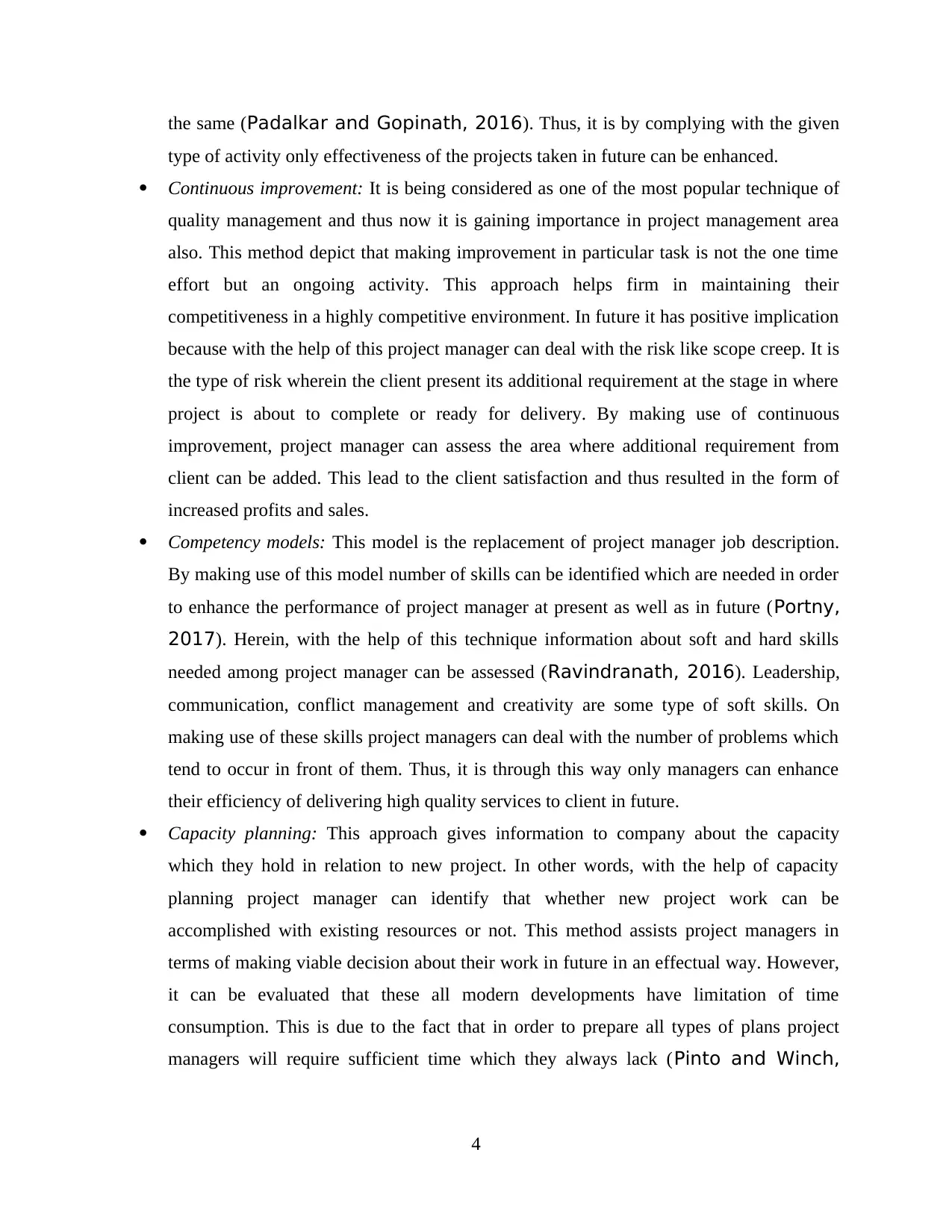
the same (Padalkar and Gopinath, 2016). Thus, it is by complying with the given
type of activity only effectiveness of the projects taken in future can be enhanced.
Continuous improvement: It is being considered as one of the most popular technique of
quality management and thus now it is gaining importance in project management area
also. This method depict that making improvement in particular task is not the one time
effort but an ongoing activity. This approach helps firm in maintaining their
competitiveness in a highly competitive environment. In future it has positive implication
because with the help of this project manager can deal with the risk like scope creep. It is
the type of risk wherein the client present its additional requirement at the stage in where
project is about to complete or ready for delivery. By making use of continuous
improvement, project manager can assess the area where additional requirement from
client can be added. This lead to the client satisfaction and thus resulted in the form of
increased profits and sales.
Competency models: This model is the replacement of project manager job description.
By making use of this model number of skills can be identified which are needed in order
to enhance the performance of project manager at present as well as in future (Portny,
2017). Herein, with the help of this technique information about soft and hard skills
needed among project manager can be assessed (Ravindranath, 2016). Leadership,
communication, conflict management and creativity are some type of soft skills. On
making use of these skills project managers can deal with the number of problems which
tend to occur in front of them. Thus, it is through this way only managers can enhance
their efficiency of delivering high quality services to client in future.
Capacity planning: This approach gives information to company about the capacity
which they hold in relation to new project. In other words, with the help of capacity
planning project manager can identify that whether new project work can be
accomplished with existing resources or not. This method assists project managers in
terms of making viable decision about their work in future in an effectual way. However,
it can be evaluated that these all modern developments have limitation of time
consumption. This is due to the fact that in order to prepare all types of plans project
managers will require sufficient time which they always lack (Pinto and Winch,
4
type of activity only effectiveness of the projects taken in future can be enhanced.
Continuous improvement: It is being considered as one of the most popular technique of
quality management and thus now it is gaining importance in project management area
also. This method depict that making improvement in particular task is not the one time
effort but an ongoing activity. This approach helps firm in maintaining their
competitiveness in a highly competitive environment. In future it has positive implication
because with the help of this project manager can deal with the risk like scope creep. It is
the type of risk wherein the client present its additional requirement at the stage in where
project is about to complete or ready for delivery. By making use of continuous
improvement, project manager can assess the area where additional requirement from
client can be added. This lead to the client satisfaction and thus resulted in the form of
increased profits and sales.
Competency models: This model is the replacement of project manager job description.
By making use of this model number of skills can be identified which are needed in order
to enhance the performance of project manager at present as well as in future (Portny,
2017). Herein, with the help of this technique information about soft and hard skills
needed among project manager can be assessed (Ravindranath, 2016). Leadership,
communication, conflict management and creativity are some type of soft skills. On
making use of these skills project managers can deal with the number of problems which
tend to occur in front of them. Thus, it is through this way only managers can enhance
their efficiency of delivering high quality services to client in future.
Capacity planning: This approach gives information to company about the capacity
which they hold in relation to new project. In other words, with the help of capacity
planning project manager can identify that whether new project work can be
accomplished with existing resources or not. This method assists project managers in
terms of making viable decision about their work in future in an effectual way. However,
it can be evaluated that these all modern developments have limitation of time
consumption. This is due to the fact that in order to prepare all types of plans project
managers will require sufficient time which they always lack (Pinto and Winch,
4
⊘ This is a preview!⊘
Do you want full access?
Subscribe today to unlock all pages.

Trusted by 1+ million students worldwide
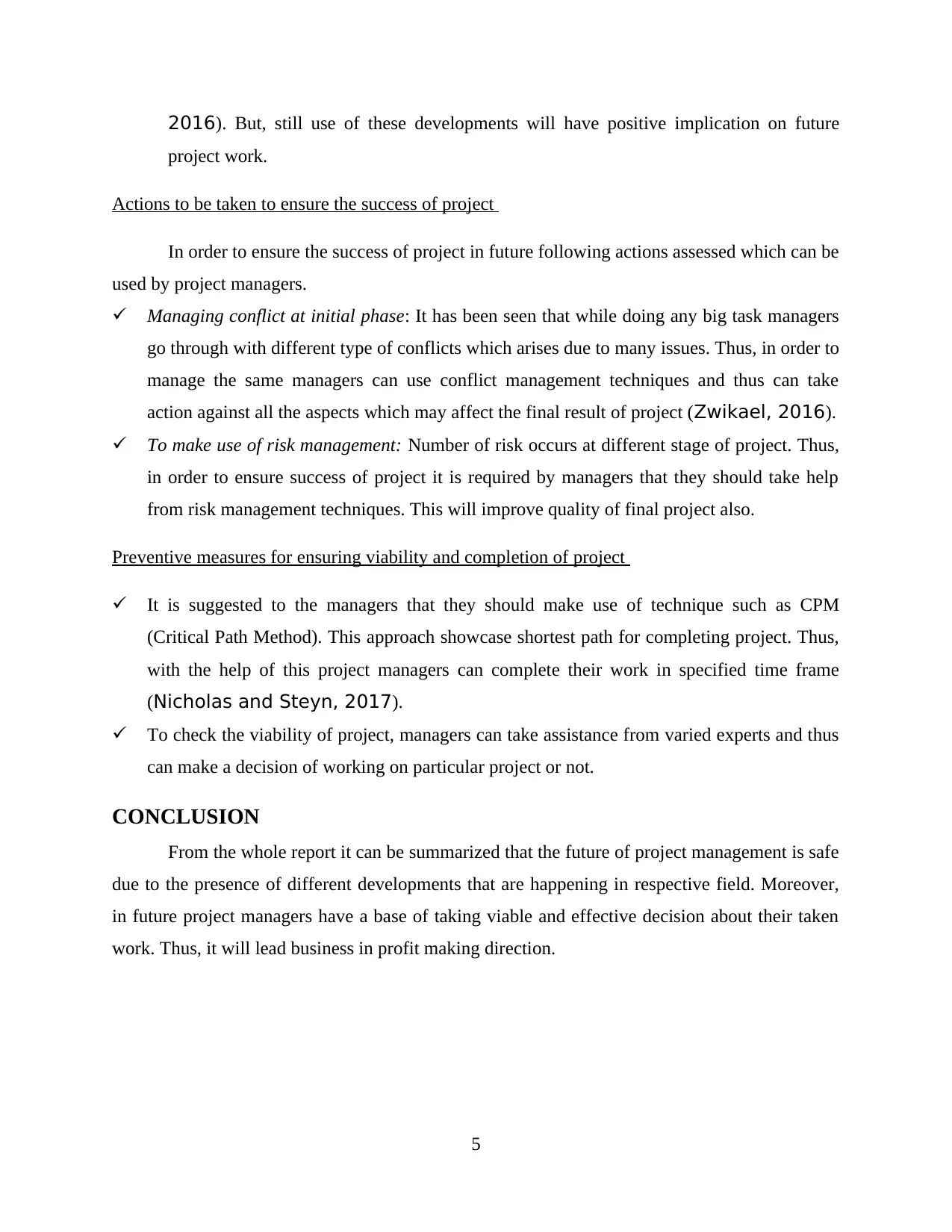
2016). But, still use of these developments will have positive implication on future
project work.
Actions to be taken to ensure the success of project
In order to ensure the success of project in future following actions assessed which can be
used by project managers.
Managing conflict at initial phase: It has been seen that while doing any big task managers
go through with different type of conflicts which arises due to many issues. Thus, in order to
manage the same managers can use conflict management techniques and thus can take
action against all the aspects which may affect the final result of project (Zwikael, 2016).
To make use of risk management: Number of risk occurs at different stage of project. Thus,
in order to ensure success of project it is required by managers that they should take help
from risk management techniques. This will improve quality of final project also.
Preventive measures for ensuring viability and completion of project
It is suggested to the managers that they should make use of technique such as CPM
(Critical Path Method). This approach showcase shortest path for completing project. Thus,
with the help of this project managers can complete their work in specified time frame
(Nicholas and Steyn, 2017).
To check the viability of project, managers can take assistance from varied experts and thus
can make a decision of working on particular project or not.
CONCLUSION
From the whole report it can be summarized that the future of project management is safe
due to the presence of different developments that are happening in respective field. Moreover,
in future project managers have a base of taking viable and effective decision about their taken
work. Thus, it will lead business in profit making direction.
5
project work.
Actions to be taken to ensure the success of project
In order to ensure the success of project in future following actions assessed which can be
used by project managers.
Managing conflict at initial phase: It has been seen that while doing any big task managers
go through with different type of conflicts which arises due to many issues. Thus, in order to
manage the same managers can use conflict management techniques and thus can take
action against all the aspects which may affect the final result of project (Zwikael, 2016).
To make use of risk management: Number of risk occurs at different stage of project. Thus,
in order to ensure success of project it is required by managers that they should take help
from risk management techniques. This will improve quality of final project also.
Preventive measures for ensuring viability and completion of project
It is suggested to the managers that they should make use of technique such as CPM
(Critical Path Method). This approach showcase shortest path for completing project. Thus,
with the help of this project managers can complete their work in specified time frame
(Nicholas and Steyn, 2017).
To check the viability of project, managers can take assistance from varied experts and thus
can make a decision of working on particular project or not.
CONCLUSION
From the whole report it can be summarized that the future of project management is safe
due to the presence of different developments that are happening in respective field. Moreover,
in future project managers have a base of taking viable and effective decision about their taken
work. Thus, it will lead business in profit making direction.
5
Paraphrase This Document
Need a fresh take? Get an instant paraphrase of this document with our AI Paraphraser
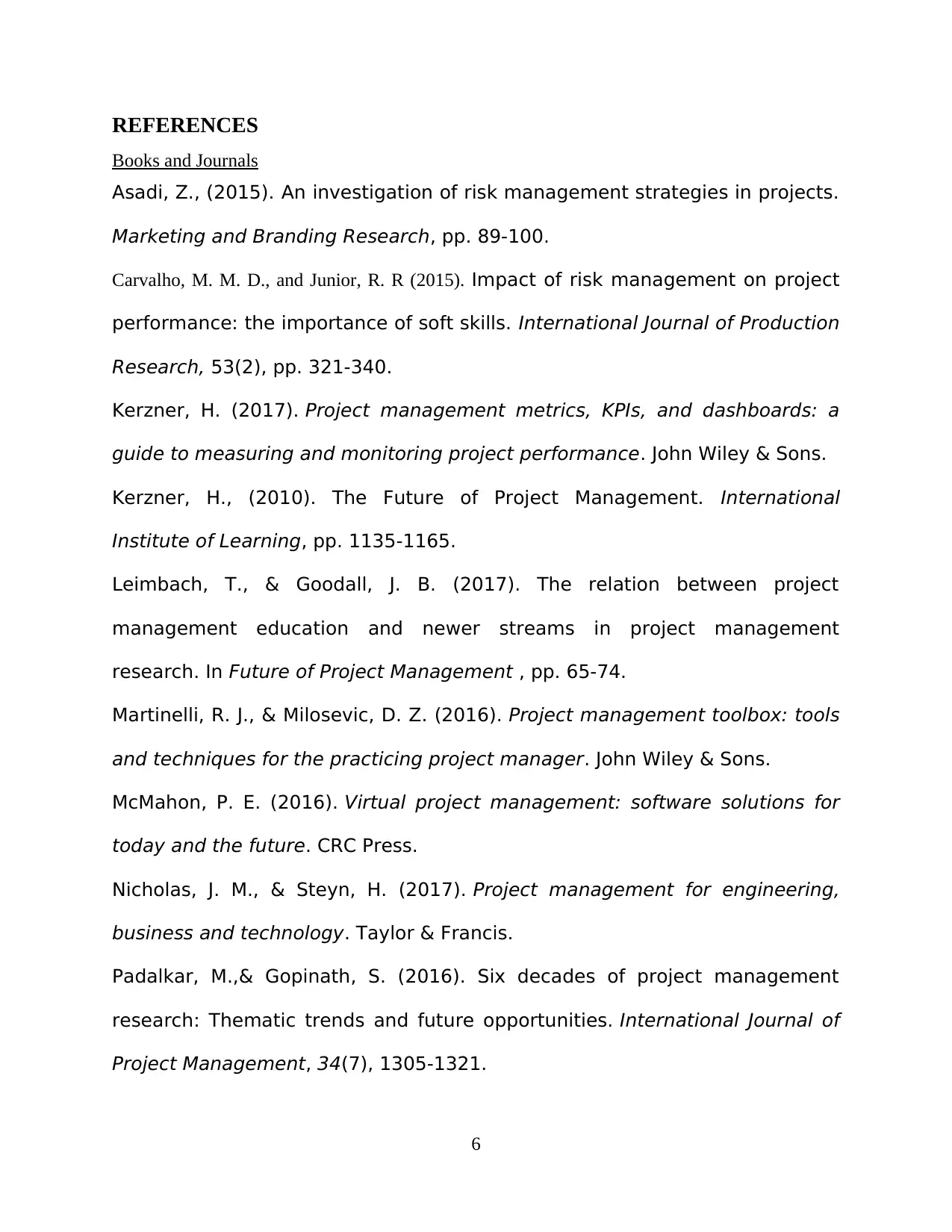
REFERENCES
Books and Journals
Asadi, Z., (2015). An investigation of risk management strategies in projects.
Marketing and Branding Research, pp. 89-100.
Carvalho, M. M. D., and Junior, R. R (2015). Impact of risk management on project
performance: the importance of soft skills. International Journal of Production
Research, 53(2), pp. 321-340.
Kerzner, H. (2017). Project management metrics, KPIs, and dashboards: a
guide to measuring and monitoring project performance. John Wiley & Sons.
Kerzner, H., (2010). The Future of Project Management. International
Institute of Learning, pp. 1135-1165.
Leimbach, T., & Goodall, J. B. (2017). The relation between project
management education and newer streams in project management
research. In Future of Project Management , pp. 65-74.
Martinelli, R. J., & Milosevic, D. Z. (2016). Project management toolbox: tools
and techniques for the practicing project manager. John Wiley & Sons.
McMahon, P. E. (2016). Virtual project management: software solutions for
today and the future. CRC Press.
Nicholas, J. M., & Steyn, H. (2017). Project management for engineering,
business and technology. Taylor & Francis.
Padalkar, M.,& Gopinath, S. (2016). Six decades of project management
research: Thematic trends and future opportunities. International Journal of
Project Management, 34(7), 1305-1321.
6
Books and Journals
Asadi, Z., (2015). An investigation of risk management strategies in projects.
Marketing and Branding Research, pp. 89-100.
Carvalho, M. M. D., and Junior, R. R (2015). Impact of risk management on project
performance: the importance of soft skills. International Journal of Production
Research, 53(2), pp. 321-340.
Kerzner, H. (2017). Project management metrics, KPIs, and dashboards: a
guide to measuring and monitoring project performance. John Wiley & Sons.
Kerzner, H., (2010). The Future of Project Management. International
Institute of Learning, pp. 1135-1165.
Leimbach, T., & Goodall, J. B. (2017). The relation between project
management education and newer streams in project management
research. In Future of Project Management , pp. 65-74.
Martinelli, R. J., & Milosevic, D. Z. (2016). Project management toolbox: tools
and techniques for the practicing project manager. John Wiley & Sons.
McMahon, P. E. (2016). Virtual project management: software solutions for
today and the future. CRC Press.
Nicholas, J. M., & Steyn, H. (2017). Project management for engineering,
business and technology. Taylor & Francis.
Padalkar, M.,& Gopinath, S. (2016). Six decades of project management
research: Thematic trends and future opportunities. International Journal of
Project Management, 34(7), 1305-1321.
6
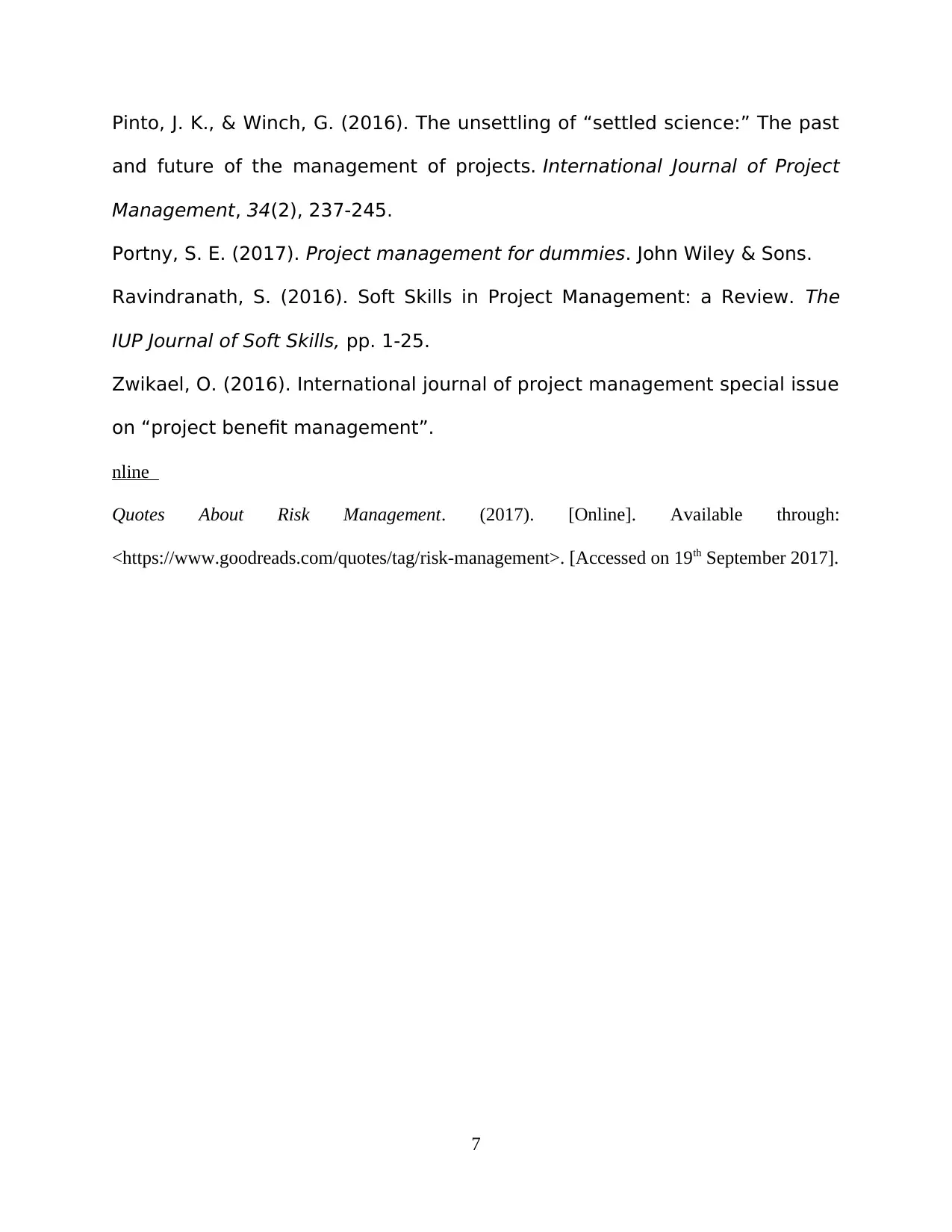
Pinto, J. K., & Winch, G. (2016). The unsettling of “settled science:” The past
and future of the management of projects. International Journal of Project
Management, 34(2), 237-245.
Portny, S. E. (2017). Project management for dummies. John Wiley & Sons.
Ravindranath, S. (2016). Soft Skills in Project Management: a Review. The
IUP Journal of Soft Skills, pp. 1-25.
Zwikael, O. (2016). International journal of project management special issue
on “project benefit management”.
nline
Quotes About Risk Management. (2017). [Online]. Available through:
<https://www.goodreads.com/quotes/tag/risk-management>. [Accessed on 19th September 2017].
7
and future of the management of projects. International Journal of Project
Management, 34(2), 237-245.
Portny, S. E. (2017). Project management for dummies. John Wiley & Sons.
Ravindranath, S. (2016). Soft Skills in Project Management: a Review. The
IUP Journal of Soft Skills, pp. 1-25.
Zwikael, O. (2016). International journal of project management special issue
on “project benefit management”.
nline
Quotes About Risk Management. (2017). [Online]. Available through:
<https://www.goodreads.com/quotes/tag/risk-management>. [Accessed on 19th September 2017].
7
⊘ This is a preview!⊘
Do you want full access?
Subscribe today to unlock all pages.

Trusted by 1+ million students worldwide
1 out of 9
Related Documents
Your All-in-One AI-Powered Toolkit for Academic Success.
+13062052269
info@desklib.com
Available 24*7 on WhatsApp / Email
![[object Object]](/_next/static/media/star-bottom.7253800d.svg)
Unlock your academic potential
Copyright © 2020–2025 A2Z Services. All Rights Reserved. Developed and managed by ZUCOL.



